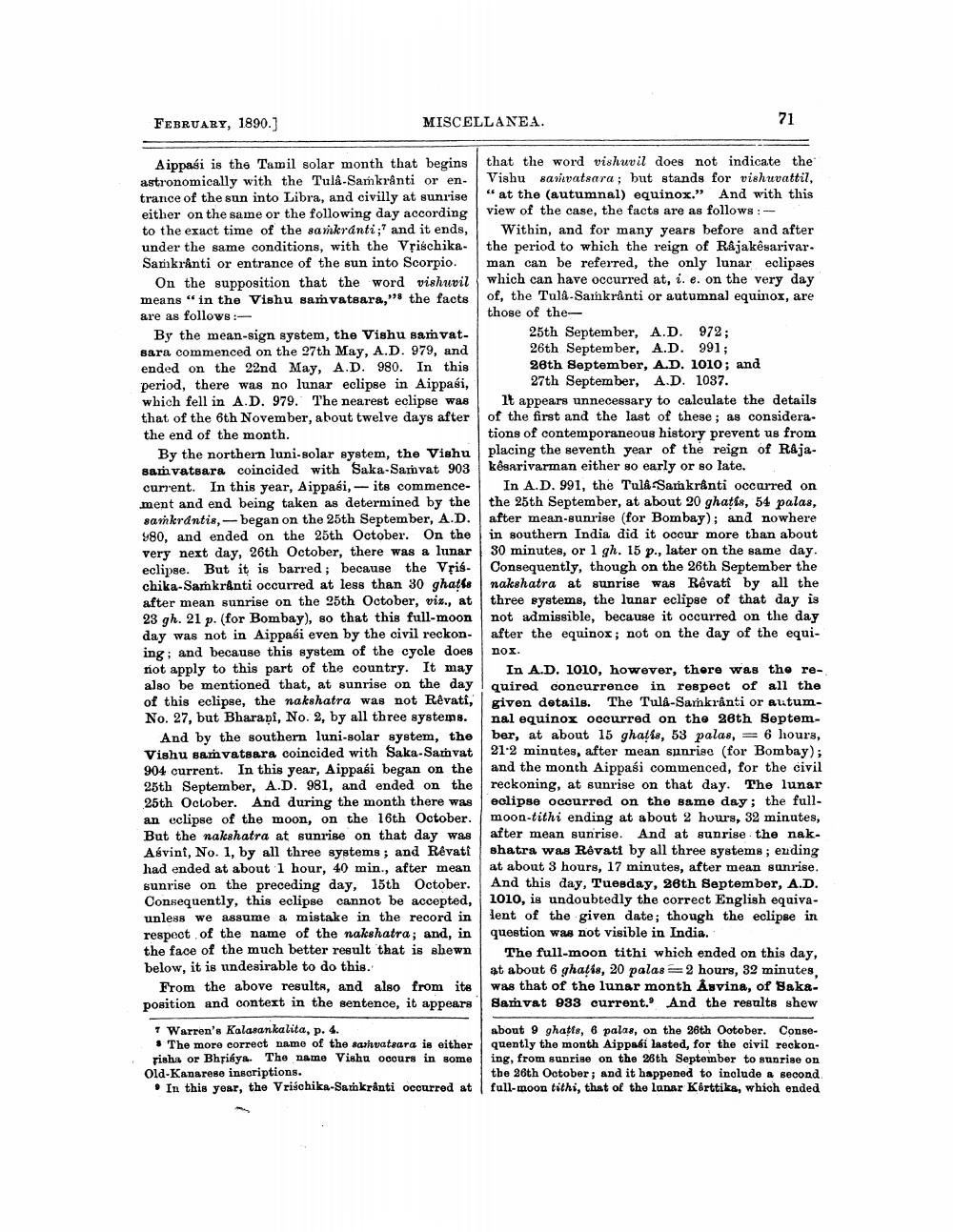________________
FEBRUARY, 1890.)
MISCELLANEA.
Aippasi is the Tamil solar month that begins that the word vishuvil does not indicate the astronomically with the Tuld-Sankranti or en. Vishu sav vatsara; but stands for viehuvattil, trance of the sun into Libra, and civilly at sunrise " at the autumnal) equinox." And with this either on the same or the following day according view of the case, the facts are as follows:to the exact time of the sankranti;' and it ends, Within, and for many years before and after under the same conditions, with the Vrischika- the period to which the reign of Rajakesarivar. Sankranti or entrance of the sun into Scorpio. man can be referred, the only lunar eclipses
On the supposition that the word vishuvil which can have occurred at, i. e. on the very day means in the Vishu samvatsara," the facts of, the Tula-Sankranti or autumnal equinox, are are as follows:
those of theBy the mean-sign system, the Vishu samvat- 25th September, A.D. 972; sara commenced on the 27th May, A.D. 979, and 26th September, A.D. 991; ended on the 22nd May, A.D.980. In this 28th September, A.D. 1010; and period, there was no lunar eclipse in Aippasi, 27th September, A.D. 1037. which fell in A.D. 979. The nearest eclipse was It appears unnecessary to calculate the details that of the 6th November, about twelve days after of the first and the last of these ; as considera. the end of the month.
tions of contemporaneous history prevent us from By the northern luni-solar system, the Vishu placing the seventh year of the reign of Rajasamvatsara coincided with Saka-Samvat 903 kesarivarman either so early or so late. current. In this year, Aippasi, - its commence- 1 In A.D. 991, the Tulá-Sankranti occurred on ment and end being taken as determined by the the 25th September, at about 20 ghatis, 54 palas, sankrantis, - began on the 25th September, A.D. after mean-sunrise (for Bombay); and nowhere 980, and ended on the 25th October. On the in southern India did it occur more than about very next day, 26th October, there was a lunar 30 minutes, or 1 gh. 15 p., later on the same day. eclipse. But it is barred; because the Vpis. Consequently, though on the 26th September the chika-Samkranti occurred at less than 30 ghatis nakshatra at sunrise was Rêvati by all the after mean sunrise on the 25th October, vit., at three systems, the lunar eclipse of that day is 23 gh. 21 p. (for Bombay), so that this full-moon not admissible, because it occurred on the day day was not in Aippasi even by the civil reckon- after the equinox; not on the day of the equiing: and because this system of the cycle does nos. not apply to this part of the country. It may In A.D. 1010, however, there was the realso be mentioned that, at sunrise on the day! quired concurrence in respect of all the of this eclipse, the nakshatra was not Rêvati, given details. The TulA-Sarnkranti or altumNo. 27, but Bharapi, No. 2, by all three systems. nal equinox occurred on the 28th Septem
And by the southern luni-solar system, the ber, at about 15 ghatis, 53 palas,> 6 hours, Vishu samvatsara coincided with Saka-Sarvat 21-2 minutes, after mean sunrise (for Bombay); 904 current. In this year, Aippasi began on the and the month Aippasi commenced, for the civil 25th September, A.D. 981, and ended on the reckoning, at sunrise on that day. The lunar 25th October. And during the month there was eclipse occurred on the same day; the fullan eclipse of the moon, on the 16th October moon-tithi ending at about 2 hours, 32 minutes, But the nakshatra at sunrise on that day was after mean sunrise. And at sunrise the nakAsvint, No. 1, by all three systems; and Rêvati shatra was Révati by all three systems; ending had ended at about 1 hour, 40 min., after mean at about 3 hours, 17 minutes, after mean sunrise. sunrise on the preceding day, 15th October. And this day, Tuesday, 26th September, A.D. Consequently, this eclipse cannot be accepted, 1010, is undoubtedly the correct English equivaunless we assume a mistake in the record in lent of the given date; though the eclipse in respect of the name of the nakshatra; and, in question was not visible in India. the face of the much better result that is shewn The full-moon tithi which ended on this day, below, it is undesirable to do this.
at about 6 ghatis, 20 palas 2 hours, 32 minutes, From the above results, and also from its was that of the lunar month Åsvina, of Sakaposition and context in the sentence, it appears Samvat 933 current. And the results shew 7 Warren's Kalasankalita, p. 4.
about 9 ghatis, 6 palaa, on the 26th Ootober. Conse• The more correct name of the sashvataara is either quently the month Aippadi lasted, for the civil reckon. risha or Bhrikya. The name Vishu cours in some ing, from sunrise on the 26th September to sunrise on Old-Kanarese inscriptions.
the 26th October, and it happened to include a second . In this year, the Vrischika Sathkranti occurred at full-moon tithi, that of the lunar Korttika, which ended




